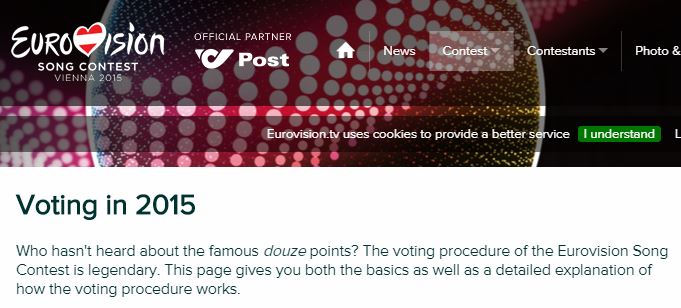Everything You Need To Know About Eurovision Voting

Table of Contents
The Two Voting Systems: Jury and Televote
The Eurovision Song Contest uses a dual voting system: 50% of the final score comes from a professional jury, and the other 50% comes from televoting by the public. This blend aims to balance expert opinion with popular preference, creating a hopefully representative outcome. Let's explore each system in more detail.
The Jury Vote
Each participating country has a national jury composed of five music industry professionals – typically musicians, composers, and music journalists. These individuals are kept anonymous until after the final to prevent undue influence or potential pressure. Their task is to independently rank all participating songs, and these rankings are then converted to points according to a pre-determined system. Usually, the top-ranked song receives 12 points, the second-ranked song gets 10 points, and so on, down to 1 point for the 10th-ranked song. Any songs ranked below 10th receive no points.
- National juries are anonymous until after the final.
- Each jury member submits their own ranking.
- Points are awarded based on a pre-determined system (e.g., 12, 10, 8...).
The jury system aims to introduce a layer of critical assessment to the competition, acknowledging musical merit beyond pure popularity. However, it's not without its controversies. Allegations of bias, bloc voting (countries consistently voting for each other), and even potential corruption have occasionally surfaced, sparking debate about the fairness and transparency of the jury voting process.
The Televote
The other half of the Eurovision voting equation comes from the public, through televoting. Viewers in each participating country can vote for their favourite song via telephone, SMS text message, or a dedicated Eurovision app. The specific methods and platforms available often vary by country due to regional differences in technology and telecommunications infrastructure. To ensure fairness, there are usually restrictions on the number of votes allowed per telephone number or IP address.
- Votes are usually counted at the close of the show.
- Each country’s televotes are aggregated to determine their points allocation.
- There are usually restrictions on the number of votes from a single number.
Safeguards are in place to prevent manipulation of the televoting results, including sophisticated systems for identifying and filtering out potentially fraudulent votes. Nonetheless, the potential for large-scale manipulation remains a concern, as evidenced by past incidents of suspected voting irregularities.
How Points are Awarded and Calculated
The point allocation system in Eurovision is relatively straightforward. Each country awards points to the other participating countries based on the combined scores from their jury and televote. The highest-ranked song receives 12 points, the second-highest 10 points, and so on, down to 1 point for the tenth-ranked song. Crucially, no country can award points to itself.
- Each country awards points to other participating countries.
- No country can vote for itself.
- A spokesperson announces the votes for each country.
Once all the votes are cast and tallied, the points from the jury and televote for each country are combined to give a final score. The country with the highest combined score is declared the winner. For example, if a country receives 80 points from the jury and 70 points from the televote, its final score would be 150 points. This combined scoring system is a key part of understanding Eurovision voting mechanics.
Understanding the Eurovision Voting Process and Rules
The Eurovision voting process is carefully orchestrated and monitored. After the performances conclude, the voting period opens, and viewers cast their votes. Following this, the jury votes are collected and processed independently, and these are then combined with the televoting results. Finally, the points awarded by each country are announced by a national spokesperson, building suspense as the results unfold.
- The voting process is carefully monitored.
- There are strict regulations to prevent fraud and manipulation.
- The results are typically verified independently.
There are rules and regulations in place to ensure fairness and prevent conflicts of interest. For instance, certain countries may be prevented from voting for other countries due to political factors or organizational constraints. One common misconception is that the voting is entirely random; this is untrue, as the system prioritizes both professional judgment and public opinion.
Controversies and Criticisms of Eurovision Voting
Despite its efforts at fairness, the Eurovision voting system has faced numerous criticisms and controversies over the years. The most prevalent is the issue of "bloc voting," where groups of countries consistently vote for each other, often based on geographical proximity, cultural ties, or political alliances. This can skew the results and potentially disadvantage countries outside these voting blocs. Neighborly voting, where countries vote for their neighbors regardless of song quality, is another frequent criticism.
- Allegations of bloc voting have occurred throughout the contest's history.
- Some argue for a more transparent and less susceptible system.
- The impact of geopolitical relations is occasionally noticeable in voting outcomes.
Other criticisms include the potential for manipulation, the lack of complete transparency in the jury voting process, and the influence of political factors on voting patterns. Proposals for reform and alternative voting methods have been made, but the current system remains in place, albeit with ongoing efforts to improve its fairness and transparency.
Conclusion
This comprehensive guide has explored the intricacies of Eurovision voting, from the jury and televote systems to point allocation and common criticisms. Understanding how Eurovision voting works enhances the enjoyment of the contest, adding another layer of appreciation to the performances and the drama surrounding the results.
Now that you’re armed with this knowledge about Eurovision voting, get ready to participate in the excitement! Learn more about the history of Eurovision voting, and tune in next year to put your newfound expertise to the test! Keep up with the latest developments surrounding Eurovision voting to ensure you're always in the know.

Featured Posts
-
 Pittsburgh Pirates And The Luis Robert Jr Trade Analyzing The Potential Profit And Arenados Contract Situation
May 19, 2025
Pittsburgh Pirates And The Luis Robert Jr Trade Analyzing The Potential Profit And Arenados Contract Situation
May 19, 2025 -
 Coupes Budgetaires Region Supprime 19 Millions Pour Universite Islamique
May 19, 2025
Coupes Budgetaires Region Supprime 19 Millions Pour Universite Islamique
May 19, 2025 -
 Philadelphia Union Defeat Orlando City In Orlando
May 19, 2025
Philadelphia Union Defeat Orlando City In Orlando
May 19, 2025 -
 Ryujinx Emulator Project Closure Official Statement Following Nintendo Contact
May 19, 2025
Ryujinx Emulator Project Closure Official Statement Following Nintendo Contact
May 19, 2025 -
 Kyriaki Toy Antipasxa Sta Ierosolyma Enas Odigos Gia Ton Proskyniti
May 19, 2025
Kyriaki Toy Antipasxa Sta Ierosolyma Enas Odigos Gia Ton Proskyniti
May 19, 2025
